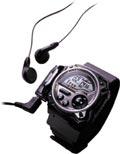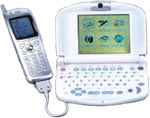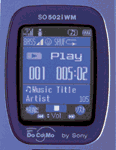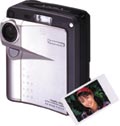Convergence Emergence
Back to Contents of Issue: May 2001
|
|
||||||||||||||||||||||||||||||||||
|
by Michael Thuresson |
||||||||||||||||||||||||||||||||||
Cellphones are leading the charge, incorporating functions from the camera, walkman, game machine, PDA, remote control, and e-wallet, among other things. But the cellphone is merely one example of Japan's convergence emergence. Washers and dryers, watches and PCs, game machines and DVD players, cameras and music machines are all blending together in ever more fascinating, complex, and compact ways. One factor behind converged appliances' popularity in Japan is the outlook of product designers, says Jun Tanaka, general manager in the Product Planning Development division at Seiko Instruments. In this country, designers tend to listen more to consumers ("the customer is God"), and rarely allow their egos or individuality to interfere with customer needs. In the West, multifunctionality is often implemented in overly complex ways, resulting in devices suitable only for hard-core gadget lovers. "Western engineers usually have their own strong intention or individuality, and that finds its way into design," says Tanaka. "Japanese engineers listen to the customer first and foremost. From the start of the design process for the Wrist Companion, we were asking groups of consumers what kind of design and functionality they wanted." (One interesting find: "The most popular watch was a keitai.") Prominent in these groups were young females, a driving force behind Japan's wireless Web industry. It's understood in Japan that a product like the Wrist Companion must be fun, simple, and hip. "We're trying to position ourselves at the convergence of technology and fashion," says Lem Fugitt, global strategy officer at Seiko. One way to make tech fashionable is to make it wearable. Having cellphones lying around cafe tables, dangling from necks, and clipped to trouser belts is not only inconvenient, but seems sloppy by Japanese standards. And in a highly mobile society like Japan, the more you can pack into a tiny gadget the more convenient it is. Hence the Wrist Companion on the following page. Another reason for Japan's love of converged appliances is the combination of complexity and subtlety -- always a central theme in Japanese culture. "We have both complexity -- traditional homes often utilize the space under the stairwell as a chest of drawers -- and an innate desire for simplicity. The Japanese tea house has nothing but the teapot and cups -- not even furniture," says Tanaka. "A good converged product reflects both these elements. It can be complex in function, yet condensed so it's efficient in use and appearance." Tanaka compares the essence of converged products to the haiku, a traditional Japanese poem that conveys deep meaning or emotion yet uses only three lines and 17 syllables. The appeal of this peculiarly Japanese approach to consumer electronics is sometimes lost on Westerners. "I'm fine with converged products if I don't have to give something up," says Ken Cotton, former president of the Tokyo PC Users Group, currently with DSL provider Tokyo Metallic Communications. "But if adding some function doesn't add more value than it subtracts, then the product won't work." On the day of our interview, he carried two cellphones, a PDA, a voice recorder, and a tape player (good retro touch). Some folks are obviously not averse to carrying around multiple devices. Converged appliances are unlikely to appeal to high-end users (such as professional photographers), and rarely do they elevate the quality of the functions they incorporate. It should also be noted that one of the coolest new additions to this family, the PDA, emerged not from Japan's consumer electronics giants, but from America's computer industry. Nevertheless, be it for fashion, simplicity, space conservation, a love of miniaturization, or an overall fastidiousness, converged appliances have struck a chord in the Japanese psyche. In the following pages, we share some of our favorite examples of this curious phenomenon.
THINK OF THIS DEVICE from Seiko's Wearable Technology Laboratory as a cellphone/PDA with a wrist mount. Few, if any, technology products have ever been more comfortable to wear than a wristwatch, and with the desktop, laptop, and palmtop ... why not a wrist-top? The Wrist Companion boldly aims to become a personal information gateway with the functionality of the cellphone, PDA, and PC. The first version, available later this year, will not replace but simply communicate with these other devices (via Bluetooth, within a 10-meter radius). Sitting in a business meeting, you could discreetly scan messages while seeming to check the time. A security feature lets you password-protect your PC as you walk away. The watch uses the same thumb input method used on most keitai. Eventually, the makers of the Wrist Companion want to squeeze in functions from all our technology and communications devices; for starters, they're giving a culture that demands fashionable technology a piece of highly wearable hardware.
AFTER THE WAR, JAPAN experienced a major home appliance revolution. By the 1970s, most Japanese homes had a color TV, an air conditioner/heater, and a washing machine. A curious statistic, though, is that by the late '90s, while approximately 99 percent of Japanese households had a washing machine, only 19 percent had a clothes dryer. Look up at apartment buildings during the day and you'll see clothes, towels, sheets, and futons hanging out of patios and windows. The obvious reason is lack of space. Up until now, this has just been an accepted inconvenience of Japanese life. But convergence changes everything. National's dual washer/dryer is about the same size as a regular, stand-alone washing machine, and it costs roughly the same as buying a washer and dryer separately. The new freedom this gives the Japanese homeowner -- from the drudgery of hanging clothes and the worry of rain, strong winds, and color-fading sunlight -- has won over many consumers. Despite mixed reviews (apparently the early models don't wash well), machines like this are displayed prominently in Akihabara (Tokyo's electronics wonderland), and salespeople say they sell well.
WHEN I-MODE TOOK OFF, many older Japanese sat on the sidelines. L-Mode, a fixed-line version of i-mode, brings these apprehensive customers into the digital world by merging the wireless Web with the familiar old home telephone and fax. According to NTT's research, what the targeted customers want is ticket reservations and banking. In particular, home-makers want email and online transactions, and senior citizens want local government service information and stock trading. Many Japanese homes already use a combined phone/fax. Sony sells a popular phone/fax/email unit (pictured above) with a simple interface (i.e., large buttons and letters) and an LCD screen. L-Mode will use a similar design, possibly made by Sony.
A WALKMAN THAT NOT only straps around your wrist like a watch, but is a watch. What would have sounded far-fetched 10 years ago now seems almost passé in Japan, where watches also serve as PDAs, cameras, cellphones, and even PCs. The WMP-1V can only play 30 minutes of CD-quality music, but a 64-meg version -- enough for a full CD -- is in the works. A USB connection transfers songs from the PC. The watch weighs just 70 grams.
THE CAMERA MARKET IS so competitive in Japan that manufacturers must constantly think of ways to differentiate new products. The Finepix 40i does more than just make itself noticed -- it combines two significantly different technologies while sacrificing little in the process. The camera offers quality color reproduction, powerful digital zoom, and 4.3-megapixel output. Insert a 64-meg SmartMedia card, and you can film up to 6 minutes of video with sound. But it's the addition of MP3 music playback that really sets this camera apart. Up to 80 minutes of music can be stored on the card. Forget about listening to tunes while you snap photos, though. Convergence inevitably hits a wall at some point.
THE CARAMIO HAS THAT effervescent innocence that can be found only in Japan. When its case is closed, it resembles a portable make-up kit -- not an accident. Eye candy for young women, this mobile email and Internet device with revolving digital camera comes in a variety of cute pastel colors. Available since mid-February, the CaraMio is an update to the Cara, which originally just did email but later added Internet browsing. Released in December 1999, the Cara had sold roughly 50,000 units by early February 2001. The digital camera is only 70,000 pixels (1 million pixels is mid-level), and the screen is bulkier than a keitai's, but the whole is definitely greater than the sum of the parts. "The camera is enjoyed more when combined with email and Web contents," observes Hideki Takemura, at TuKa's CaraMio design team. For example, users can easily send and receive images together with text messages. The CaraMio can also communicate with a cellphone via a cable. Anybody who uses mobile communications and the Net for predominantly social and entertainment reasons would get a kick out of the CaraMio. There are about 30 million Japanese girls and boys fitting that description.
NAVIGATING YOUR WAY THROUGH Japan is a nightmare, even if you're Japanese. Unbelievably, addresses here do not indicate the actual location of a residence, only the district designation and name of the building, if it has one. The first DVD-based car navigation systems were launched in 1997, and became popular partly because a single disc can hold enough data to cover all of Japan. (The old CD-ROM models were unwieldy, requiring seven discs.) Panasonic's best-selling DVD-navigation system allows drivers to search and choose from a variety of possible routes. This version turns a car into a complete entertainment system. With a 64-bit RISC processor, the unit handles DVD video and CD audio, and accesses the Net through the user's cellphone connection. It also sports a 7" color LCD screen, a TV tuner, digital surround sound, and a remote control so even backseat drivers can master the mix. Do Japanese drivers really want all this? Yano Research Institute estimates that 70 percent of the 530,000 DVD-equipped navigation systems sold in Japan last year were Internet-compatible. The same report predicted that such devices would continue to drive the market.
THE MOTIVATION FOR THIS device is obvious. Cellphones and digital cameras are particularly popular items in Japan, so why not put them together? The Japanese, with their notorious affinity for photography, can find a use for cameras of just about any shape or form. The camera's appeal is in its simplicity. The lens is located on the back of the phone; you press a key on the front dial pad to take a photo. To take a photo of yourself, there's a small mirror next to the lens to help you get aligned. You can then send and receive the 256-color images by email, as well as save photos in the phone's memory. Unsurprisingly, the camera is little more than a simple toy. Viewing a digital photo on a cellphone's screen, while fun and convenient, will never come close to the experience of seeing it on a larger and higher resolution screen -- or on paper. This is fine, though, because the camera adds enjoyment to the cellphone without adding too much complexity. J-Phone has a strategic reason for pushing the J-SH04. This month NTT DoCoMo should become the first operator in the world to provide third-generation cellular service, the main characteristic of which is fast, smooth transmission of moving images. J-Phone's 3G network won't be running until at least June 2002, so with the J-SH04, J-Phone hopes to establish itself early as the cellphone-camera company.
THE CONVERGENCE OF THE ultimate digital and analog devices, the Flap is a corporate solution that combines a telephone and a PC in a compact fold-up case that fits easily on the corner of a desk. Like everywhere else in Japan, space is very limited in offices. Put a typical PC, monitor, and phone on a Japanese worker's desk, and there's not much room for anything else. The Flap's PC is a "dumb" terminal that uses a LAN server for its CPU functions. When the keyboard is folded up, you can still use the phone and fax. Saving space wasn't NEC's only inspiration for the Flap. "The recycling time of the PC and the telephone are converging," notes Toru Ichihashi, corporate products designer at NEC. Purchasing and accounting departments will surely appreciate the convergence that takes place on the spreadsheets.
CELLPHONES AND PORTABLE MUSIC players are constant electronic companions for Japan's urban dwellers. Why not merge the two functions? It's a no-brainer, and with this model heavy hitters NTT DoCoMo and Sony add leverage and name recognition to the concept. The unit includes a 256-color LCD with a 120-by-160-pixel resolution. A special function allows users to shut off the phone for uninterrupted music. The MP3 player utilizes the Magic Gate Memory Stick from Sony, incorporating copyright protection technology to manage music downloaded from the Internet, CDs, or other sources. A Memory Stick providing about 1 hour's worth of listening is included, but to transfer music from a PC to the Stick, you need ¥9,800 OpenMG Jukebox software. It may be difficult to swap songs, but users can directly store CD music on the device from their home music players. In Japan, the price of cellphone handsets is subsidized by the dealers and carriers, which is why this new telephone is available for less than half its original list price. And with the arrival of DoCoMo's i-Appli Java-enabled phones, this particular model is no longer cutting-edge, causing the price to drop even further. In contrast, Sprint and Samsung released an MP3 phone in the US last fall that retails for about $400.
AFTER TAKING A PHOTO, your natural preference is to view it immediately. A built-in printer instantly gratifies this desire -- such was the appeal of old film-based Polaroids. But what many of us would really like to do is look at our picture, try again until we get it right, and then, finally, print it. Hence the Finepix PR21, which combines the best functions of the Polaroid and digital camera. The price has been drastically reduced from ¥99,800 to a street value of ¥29,800, perhaps because its relative clunkiness (it weighs 550 grams) is unattractive in Japan. In fairness to Fujifilm, maybe consumers here are being unrealistic. After all, how small can you make a printer?
THE MOBILE7 WON'T BE available for at least another 16 months, but its boldness, design, and functionality definitely make it worth mentioning. Not only does this device combine a cellphone and a PDA, it also adds a video camera. Technical specifications aren't decided yet (though we know Bluetooth will be in there), but it will likely use a high-resolution, organic luminescent display. Organic screens, which offer incredible color, speed, and compactness (see "Through Thick and Thin," page 6, March 2001), will soon be the screen technology of choice for most high-end mobile devices. According to NEC, the Mobile7 will let you take video on the camera, add text on the PDA, and transmit complete multimedia messages via the phone unit. How long, though, before even this seems passé? |
||||||||||||||||||||||||||||||||||
Note: The function "email this page" is currently not supported for this page.






















